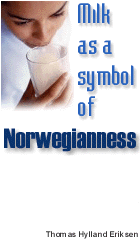|
|
 Resources and industry
Resources and industry
|
Copyright © 1994-2002 Encyclopedia Britannica, Inc.
By the mid-1990s Norway had become the world's second largest oil exporter (behind Saudi Arabia), with daily production of more than three million barrels. The first commercially important discovery of petroleum on Norway's continental shelf was made at the Ekofisk field in the North Sea late in 1969, just as foreign oil companies were about to give up after four years of exploratory drilling. Intensified exploration increased reserves faster than production. Nevertheless, by the mid-1990s about half of export earnings and nearly one-tenth of government revenues came from offshore oil and gas, and these revenues continued to increase as the end of the century approached. It was estimated that the high rate of oil production could be sustained at least into the second decade of the 21st century, while that of natural gas was projected to increase dramatically and be sustained even longer.
More than one-fourth of the huge investment made in Norwegian offshore operations by the mid-1990s went toward the development of the Troll field just west of Bergen, one of the largest offshore gas fields ever found. Its development ranked as one of the world's largest energy projects. With a water displacement of one million tons and a height of nearly 1,550 feet, the Troll A production platform was the tallest concrete structure ever moved when it was towed into place in 1995. Gas deliveries from the Troll field made Norway a leading supplier of natural gas to continental Europe.
With an area of more than 386,000 square miles (1,000,000 square km), Norway's continental shelf is about three times as large as the country's land area. The rich resources found there are largely responsible for an ongoing boundary dispute between Norway and Russia. Negotiations between the two countries, begun in 1974, involve competing approaches to the line separating their claims in the Barents Sea. The contested area is estimated to be about 60,000 square miles (155,000 square km). Norway insists on a midline partition, while Russia insists on a partition based on a sector principle that would make 32° E the dividing line.
About half of Norway's 65,000 largest lakes are situated at elevations of at least 1,650 feet (500 metres), about one-fifth of the country lies 2,950 feet (900 metres) or more above sea level, and predominantly westerly winds create abundant precipitation. As a result, Norway has tremendous hydroelectric potential. It is estimated that almost one-third of that potential is economically exploitable, of which more than three-fifths had been developed by the mid-1990s. Some 850 hydropower stations meet virtually all Norway's electrical consumption needs. Norway's per capita production of electricity is the world's highest, twice that of the United States.
About one-third of the country's production of electricity is utilized by the electrometallurgical industry, which is Europe's largest producer of aluminum and magnesium. In addition to being among the world's leading exporters of metals, Norway is a significant producer of iron-based alloys. Europe's largest deposit of ilmenite (titanium ore) is located in southwestern Norway. The country also is the world's principal producer of olivine and an important supplier of nepheline syenite and dimension stone (particularly larvikite). Pyrites and small amounts of copper and zinc also are mined, and coal is mined on Svalbard.
In all, mining and manufacturing (excluding petroleum activities) account for more than one-third of Norway's export earnings. Metals and engineering are the two main subgroups, each accounting for about one-fifth of nonpetroleum exports. Engineering industry exports doubled in the mid-1990s, the largest increase in 15 years. The level of petroleum-related investment is crucial for the engineering industry, which accounted for about one-third of the manufacturing workforce in the late 1990s. With the decline of traditional shipbuilding beginning in 1980, the importance of the production of equipment for the petroleum industry increased. Supply ships and semisubmersible drilling platforms are exported worldwide, and the Norwegian-designed Condeep production platforms (such as Troll A) are well-suited to the rough seas off Norway's shores.
|
 |
|
Anons |

|
| Links |


|
|
Partner
|

|
|

